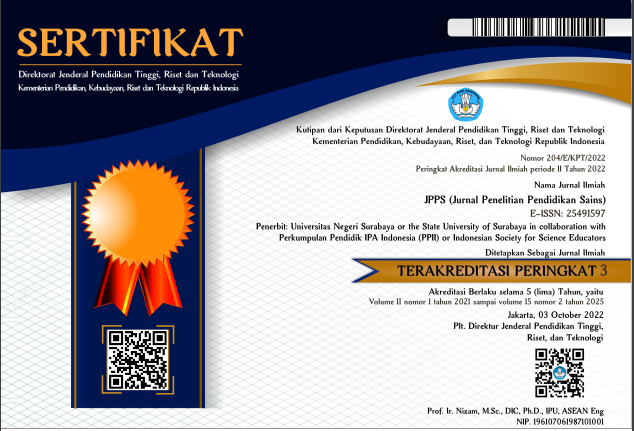Mental Models in Chemistry: Prospective Chemistry Teachers’ Mental Models of Chemical Equilibrium
DOI:
https://doi.org/10.26740/jpps.v11n2.p113-129Keywords:
Chemistry, Chemical equilibrium, Mental models, Prospective chemistry teachersAbstract
In this study, we described research into prospective chemistry teachers' mental models for chemical equilibrium. This research aimed to describe the profile of prospective chemistry teachers' mental models of chemical equilibrium. This study was held at one university in Tangerang. The subjects in this study were 22 students. The method used is the descriptive research method, using diagnostic tests as a research instrument. The research outcome showed 59.42% for the macroscopic stage, 51.34% sub-microscopic stage, and 66.18% symbolic stage. This outcome showed the variety of the understanding of prospective chemistry teachers for every level of chemical representation but generally, the understanding at the submicroscopic level was still relatively low. The profile of the mental models at each level of representation showed varied results but on average has a higher percentage in the Phenomenon Model and the Character-Symbol Model. The category of mental models at each level of representation mainly shows a linkage between the characteristic of the level of representation and the students’ mental model type. The result of this work point to the need of developing a learning strategy that accommodates the multiple representations. The next study also should recognize that sub-microscopic level representation is very important as this level help the students understand the scientific concept and give the correct explanation to chemical phenomena and reduce the misconception.
Downloads
References
Arikunto, S. (2009). Dasar-dasar evaluasi pendidikan. Bumi Aksara.
Devetak, I. (2005). Explaining the latent structure of understanding submicropresentations in science. Slovenia: University of Ljubljana.
Hono, A.S., Yuanita, L., & Suyono, S. (2017). Penerapan model learning cycle 7e untuk memprevensi terjadinya miskonsepsi siswa pada konsep reaksi redoks. JPPS (Jurnal Penelitian Pendidikan Sains), 3(2), 354. https://doi.org/10.26740/jpps.v3n2.p354-360
Johnson-Laird, P. (1983). Mental models: Towards a cognitive science of language, inference and consciousness. Cambridge: Harvard University Press.
Johnstone, A.H. (2009). Foreword, in gilbert j. k. and treagust d. f. (ed.), multiple representations in chemical education. Berlin: Springer.
Rahmi, C., Wiji, W., & Mulyani, S. (2020). Model mental miskonsepsi pada konsep kesetimbangan kelarutan. Lantanida Journal, 8(1), 64. https://doi.org/10.22373/lj.v8i1.7108
Suja, I.W., Sudiana, I.K., Redhana, I.W., & Sudria, I.B.N. (2021). Mental model of prospective chemistry teachers on electrolyte and nonelectrolyte solutions. IOP Conference Series: Materials Science and Engineering, 1115(1), 012064. https://doi.org/10.1088/1757-899x/1115/1/012064
Downloads
Published
How to Cite
Issue
Section
License
Copyright (c) 2022 JPPS (Jurnal Penelitian Pendidikan Sains)

This work is licensed under a Creative Commons Attribution-ShareAlike 4.0 International License.
 Abstract views: 593
,
Abstract views: 593
, PDF Downloads: 484
PDF Downloads: 484












